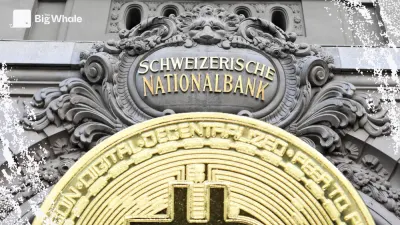TBW - What are the best tokenised S&P 500 indices?

Tokenisation is moving ahead at high speed. After stablecoins, it is now spreading to equities, bonds and even stock market indices. The S&P 500, buoyed by all-time highs, is becoming one of the new grounds for on-chain experimentation.
But one issue is emerging: are all tokenised versions of the S&P 500 the same? Several players are already offering their own versions - bCSPX (Backed), SPYX (xStocks), SPXA (Centrifuge), SPYON (Ondo) - with very different architectures, guarantees and levels of compliance.
In brief
- bCSPX (Backed) → Highly regulated institutional showcase, but almost unusable in DeFi.
- SPYX (xStocks) → The most accessible, consumer-oriented, and liquid option.
- SPXA (Centrifuge) → Innovative institutional product, the only true official S&P 500 on-chain index - but still unusable.
- SPYON (Ondo) → Institutional bridge "compliant" with traditional finance, controlled distribution and very limited retail access.
Why tokenise an index like the S&P 500?
The S&P 500 is the world's most closely followed index, covering 80% of the US market and serving as a benchmark for investors. The rationale behind tokenising it is simple: to offer a version that is continuously accessible, transparent and more open than traditional ETFs.
On-chain, the index can be bought or sold 24 hours a day without being dependent on Wall Street hours, and each transaction is recorded in a smart contract, which enhances traceability and visibility of the product.
But there are grey areas in this innovation: a regulatory framework that is still unclear, a dependence on reliable oracles to faithfully reflect the real index, and the technological risk inherent in smart contracts (bugs, flaws, attacks).
Backed - bCSPX
bCSPX is one of those tokenised products that show just how far traditional finance can already go on-chain. In concrete terms, Backed Assets - a Swiss company, via a subsidiary registered in Jersey - is tokenising the performance of BlackRock's iShares Core S&P 500 UCITS ETF (CSPX). Put another way: owning bCSPX is tantamount to gaining exposure to the S&P 500, but in the form of a token.
The mechanics are simple, but the structure is highly controlled. The ETF units are held by ISP Securities AG, a Zurich custodian supervised by FINMA. This point is essential: unlike "synthetic" tokens, which are based solely on a price oracle, the bCSPX is backed by a real asset. The token therefore reflects a tangible asset, with the same economic rights as an ETF share.
Access, however, is far from open to everyone. To buy or redeem bCSPX directly from Backed, you need to go through a full KYC/AML and be recognised as an accredited investor - a financial institution, large corporation, or high net worth individual. The product is registered not only in Jersey, but also in Switzerland and Liechtenstein, which means double regulatory control. As a result, only qualified European and Swiss investors can interact with the issuer.
This does not prevent the token from circulating a little in the DeFi, but on a limited basis. A bCSPX/sDAI pool is available on Balancer (Gnosis Chain), with around $130,000 in TVL and nearly $500,000 in monthly volume. Trading is permitted without KYC, but liquidity remains very low: an order of more than $30,000 already creates a significant slippage. The token is also not listed on CEXs, which further limits its distribution.
In these conditions, the composability of the bCSPX remains reduced. The token is not accepted as collateral by any of the major protocols and offers few on-chain uses, apart from providing liquidity on Balancer - a protocol that itself suffered a $129 million hack in early November. Returns are low and exposed to the classic risk of impermanent loss.
In reality, bCSPX is more like a full-scale demonstration: a product that proves that regulated tokenisation of complex financial assets is possible, but which is not yet designed for large-scale decentralised use. It's a foretaste of what tokenisation could become... when the infrastructures and regulations are ready.
xStocks - SPYX
With the SPYX, xStocks is offering a much more accessible version of the tokenised S&P 500. The product replicates the performance of the SPDR S&P 500 ETF (SPY), one of the world's best-known investment vehicles. Technically, it relies on Backed's issuance infrastructure - the same as for the bCSPX - but with a very different positioning.
Where the bCSPX clearly targets institutional investors, the SPYX assumes a broader ambition: to allow any individual to buy exposure to the S&P 500 in the form of a token. xStocks is in charge of distribution, with a resolutely consumer-oriented message: "Investing Designed for Everyone."
Each token is backed by real units of the SPY ETF, held with approved custodians such as Alpaca, Incore or Maerki Baumann. Access works on a semi-open model: mint and redeem require KYC/AML, but once the tokens have been issued, they circulate freely on compatible blockchains. And here, the team is clearly banking on multichain. SPYX already exists on Solana and Ethereum, and is due to arrive soon on Arbitrum and BNB Chain.
Distribution follows the same logic: being visible wherever users are. SPYX is present on several DEXs - Raydium, Orca, Meteora, PancakeSwap (Solana version) - which facilitates retail access. It is also listed on Kraken and Bybit, although access is still restricted: not available to US, Canadian, UK or Australian customers.
On the regulatory side, Backed here uses only its Liechtenstein structure, with no direct Swiss supervision. The result is a lighter, more agile product... but certainly less reassuring for institutional investors who need a strict framework.
On liquidity, SPYX has a clear advantage over bCSPX. Its daily volume is around $405,000, almost as much as bCSPX's monthly activity. Depth is decent up to $20,000 to $40,000 of orders, even if slippage becomes noticeable beyond that.
But the real novelty is in composability. SPYX is beginning to find its place in DeFi: on Kamino Finance, it can now be deposited as collateral to borrow USDC or other assets. Kamino's 'xStocks market' already has $1.23 million in deposits - a modest but symbolic start. For the first time, exposure to the S&P 500 becomes usable in an on-chain lending protocol.
SPYX is the consumer version of the tokenised S&P 500. While the bCSPX remains a regulatory showcase for pros, the SPYX explores what real integration between TradFi and DeFi could look like: a simple, multichannel, exchangeable and already partially composable product. A gateway to a future where stock market indices themselves circulate freely on-chain.
Centrifuge - SPXA
With SPXA, Centrifuge is taking a step that the industry has been talking about for years but never achieved: bringing a major stock market index to life directly on-chain. Founded in 2017 and a pioneer in RWAs, the German company is signing up to one of the most ambitious developments in the sector with this product launched at the end of September 2025: the first blockchain-native S&P 500 index fund, created in official collaboration with S&P Dow Jones Indices - a world first.
Unlike the approaches of Backed or xStocks, SPXA does not tokenise an existing ETF. It recreates the index itself, from the source. To achieve this, Centrifuge has developed a novel system, the Proof of Index, which links S&P DJI's certified data files to smart contracts deployed on Base, the blockchain supported by Coinbase. The result: the SPXA replicates the performance of the S&P 500 in near-real time, with verified and audited data, without relying on external oracles.
The model is completely different: here, the index becomes a programmable asset. SPXA borrows from both traditional asset management (via a strict regulatory framework, a professional manager and classic governance) and decentralised finance (automation, transparency, on-chain execution). The product is administered by Anemoy Capital, Centrifuge's management company, with Janus Henderson as sub-manager - a partnership that validates institutional DeFi's entry into the index world.
Access, for now, remains extremely restricted. The SPXA is 100% permissioned: reserved for qualified non-US investors, with a minimum ticket of $500,000 and a full KYC/AML. The issue is backed by a Luxembourg vehicle, Anemoy Capital S.A., aligned with European asset management standards. The ambition is clear: to offer institutions a product that ticks all the regulatory boxes while exploiting the benefits of blockchain.
At this stage, no secondary liquidity exists. SPXA is still in its launch phase, and data from RWA.xyz shows that a single address holds around $5m of tokens - presumably the initial institutional investor. No DeFi market, no CEX or DEX listings, no integration as collateral. Centrifuge does, however, plan to activate bridges via Wormhole, which could eventually pave the way for multi-chain use.
SpXA is therefore positioned in a category of its own. Where bCSPX and SPYX seek above all to bring the S&P 500 to crypto users, SPXA explicitly targets institutions and offers a product directly backed by the index, under official licence, with proprietary technology that could become a standard. If index tokenisation becomes established in regulated portfolios, it is probably this type of architecture - and perhaps this product - that will serve as a model
Ondo - SPYON
With SPYON, Ondo Finance is extending its strategy beyond the tokenisation of sovereign bonds to tackle equity indices. Known for its products backed by US Treasuries - such as USDY and OUSG, now among the largest on the market - the company is now offering on-chain exposure to the S&P 500 index, via a product directly backed by the SPDR S&P 500 ETF (SPY), managed by State Street Global Advisors.
According to data from RWA.xyz, SPYON is currently the largest SPY-based tokenisation, with approximately $25 million in tokenised assets as of mid-November 2025. The product is issued via Ondo Global Markets (OGM), a platform designed to offer non-US investors on-chain exposure to listed securities, whether equities, ETFs or indices.
OGM tokens, like the SPYON, are backed by real assets held in reserve, guaranteeing the same economic exposure as direct ownership of the underlying asset, dividends included and reinvested net of tax. However, these tokens do not grant voting rights or legal ownership of the securities. They function as "total return trackers", i.e. products that fully reproduce the economic performance of the asset without transferring legal ownership.
For the time being, the product remains reserved for institutional investors. Access requires a full onboarding process via Persona and HelloSign, compliant with KYC/AML requirements. A gradual opening to retail investors is envisaged, but is not yet active. On the secondary market, SPYON is available on a few partner CEXs, notably Gate and Bitget, which facilitates its access to a non-US audience, albeit in a supervised manner.
On the liquidity side, Ondo benefits from its existing ecosystem: its flagship products have accumulated several hundred million dollars in TVL, providing a solid infrastructure for the development of new markets. SPYON, which is still in its infancy, has limited but growing liquidity, and Ondo is working to structure institutional market depth via approved partners and whitelisted DEXs. The objective is explicit: to replicate the liquidity of traditional markets and reduce price differentials between the real asset and its tokenised version, thanks to instantaneous, no-cost mint/burn mechanisms.
The DeFi composability of SPYON is deliberately limited. Ondo favours a regulated DeFi approach, integrated with protocols compatible with institutional requirements. SPYON can thus be found in Flux Finance, a lending protocol supervised by Ondo, specifically designed to host compliant tokenised assets.
At this stage, free circulation of SPYON remains almost non-existent. A few fragments are appearing on Uniswap, but liquidity there is insignificant (around $10,000), making any significant transaction impossible without a strong impact on the price. For retail investors, access to SPYON therefore remains virtually closed, at least until more public channels open up.
To put it simply, SPYON embodies the institutional and regulated version of the tokenised S&P 500. Where xStocks focuses on accessibility and Backed on compliance, Ondo seeks to create a stable bridge between financial markets and DeFi, with a professional on-chain finance logic.
>> Discover our Tokenization Dashboard
>> Tokenization Briefing (Q3 2025)



